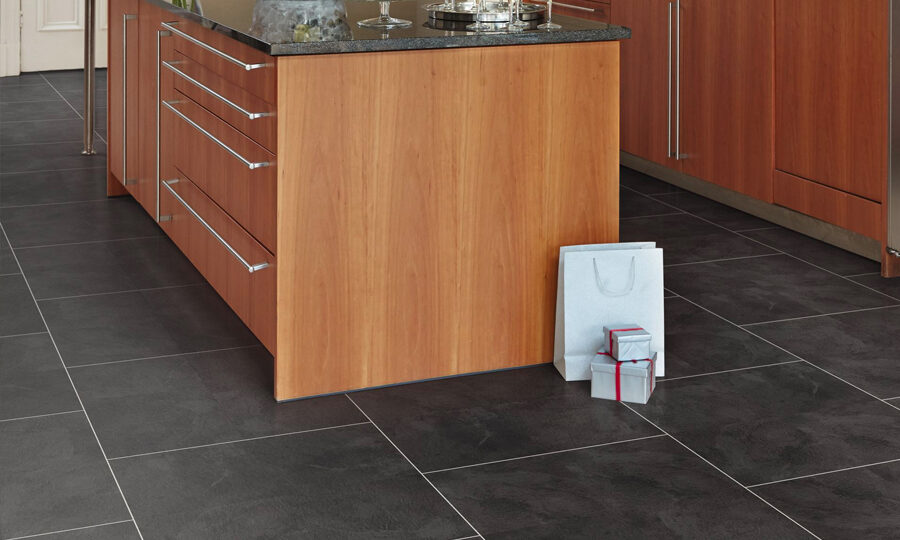Luxury Vinyl Tiles (LVT) have become increasingly popular in recent years, thanks to their affordability, durability, and wide range of design options. This comprehensive guide to luxury vinyl tile aims to provide you with a detailed walkthrough of two common installation methods for installing luxury vinyl tiles – Glue down and click lock LVT flooring.
Please ensure that all surfaces you are fitting your new LVT flooring on are completely flat and you make sure you ensure if your luxury vinyl flooring requires it you have LVT underlay to hand. It is important to use the right underlay as it may void your warranty, if you are unsure of this please double-check with the supplier you are purchasing from.
Install Luxury Vinyl Tiles – Glue Down Method
Step 1: Preparing the Subfloor
Before commencing the new floor installation, it is crucial to ensure that the subfloor is thoroughly cleaned, smooth, and free from any debris or imperfections that could affect the final result. This includes removing any existing flooring, such as carpet or vinyl, and repairing any cracks or uneven areas.
Step 2: Acclimating the Luxury vinyl tiles
To achieve the best results, it is recommended to acclimate the LVT by storing it in the room where it will be installed for at least 48 hours. This allows the material to adjust to the temperature and humidity of the environment, minimising any potential issues that may arise later in the fitting process. It is important to note that different LVT floor products may have specific acclimation requirements, so be sure to check the manufacturer’s instructions.
Step 3: Measuring the Room
Accurate measurements are essential to minimise wastage and ensure a perfect fit. Measure the length and width of the room, and calculate the total square footage required for the installation. Take into account any irregularities or obstacles in the room, such as doorways or cabinets, and plan accordingly.
Step 4: Applying the Adhesive
Begin the installation process by applying the recommended adhesive to the subfloor using a trowel. It is crucial to follow the instructions to ensure proper application and to achieve the desired bond between the LVT and the subfloor. Consider applying the adhesive in small sections to the concrete floor to prevent it from drying out before the tiles are laid.
Step 5: Laying the Luxury Vinyl Tiles
Starting from the centre of the room, press the first tile firmly into the adhesive. Continue this process, working your way towards the walls, while ensuring that the tiles are aligned correctly. Take your time to ensure a seamless and visually appealing installation. If necessary, use tile spacers to maintain consistent spacing between the tiles.
Step 6: Rolling the Floor
Once all the tiles are in place, use a flooring roller to apply pressure evenly across the entire floor. This helps to ensure a strong bond between the tiles and the adhesive, resulting in a more durable and long-lasting LVT floor. Pay extra attention to the edges and corners to ensure proper adhesion.
Step 7: Cutting and Fitting the Boards
For the final row, you may need to cut the LVT to fit using a utility knife. Take precise measurements and make accurate cuts to achieve a snug fit without any noticeable gaps. This attention to detail will contribute to the overall professional appearance. Consider using a straight edge or a template to guide your cuts for better accuracy.
Step 8: Cleaning and Sealing
After completing the installation, remove any adhesive residue from the surface of the LVT. Follow the manufacturer’s recommendations for cleaning products and methods. Additionally, consider applying a suitable sealer to protect the vinyl floor topping and enhance its longevity. Regular cleaning and maintenance will help to keep the LVT looking its best for years to come.
By following these detailed steps, you can ensure a successful and professional installation of glue-down LVT flooring. Remember to refer to the manufacturer’s instructions and seek professional advice if needed.
Click Luxury Vinyl Flooring Installation
Step 1: Preparing the Subfloor
Similar to the glue-down method, it is important to ensure that the subfloor is clean, smooth, and free from any debris or imperfections that may affect the installation of the click LVT flooring. Start by thoroughly sweeping and vacuuming the subfloor to remove any dirt or dust. Next, inspect the surface for any uneven areas or protrusions, and use a floor levelling compound or sandpaper to smoothen them out. Lastly, ensure that the subfloor is dry and moisture-free to prevent any issues with the LVT installation.
Step 2: Acclimating the LVT
Allow the LVT to acclimate in the room where it will be installed for at least 48 hours. This period of acclimation is crucial as it allows the material to adjust to the temperature and humidity of the environment, ensuring a stable and long-lasting installation. It is recommended to keep the LVT boxes unopened during this time and to store them in a well-ventilated area away from direct sunlight.
Step 3: Measuring the Room
Measure right length of the room accurately and calculate the total square footage required for the installation. This will help you plan the placement of the click LVT tiles efficiently and minimise any wastage. Use a tape measure to measure the length and width of the room, and multiply the two measurements to get the total square footage. It’s always a good idea to add a few extra square feet to account for any cutting errors or future repairs.
Step 4: Positioning the First Row
Unlike the glue-down method, click installation starts at one wall and works the same way across the room. Start by determining the most visible wall or the one that you want to align the flooring with. Place the first row of LVT planks with the grooves facing the wall, ensuring a snug fit between each plank. Use spacers or wedges to maintain a consistent expansion gap along the wall.
Step 5: Securing the Boards
Click each board together, ensuring a tight fit. The click system provides a convenient and secure way to join the LVT planks without the need for additional adhesives. Apply gentle pressure to the boards, making sure they lock into place. Use a tapping block and rubber mallet to ensure a snug connection between the planks.
Step 6: Laying the Boards
Continue working in rows from one side of the room to the other, making sure each board is securely locked into place. Take care to align the planks properly for a uniform and visually appealing installation. Use a combination of full-length planks and cut pieces to achieve a staggered layout pattern. Remember to maintain the recommended expansion gap along all walls.
Step 7: Cutting and Installing the Final Row
Measure and cut the next row of the LVT to fit the remaining space using a utility knife. Pay attention to detail and ensure a precise fit to maintain the overall aesthetics of the wood flooring. Use a straight edge or a carpenter’s square to guide your cuts, and be careful not to damage the surrounding planks. Once the final row is cut, click the planks into place, ensuring a seamless transition with the rest of the flooring.
Step 8: Cleaning and Inspecting
After completing step by step guide to the installation, take the time to thoroughly clean the top vinyl flooring, to remove any dust, debris, or residue. Use a soft-bristle broom or vacuum cleaner to sweep the surface, followed by a damp mop using a mild cleaning solution specifically designed for LVT flooring. Inspect the surface for any gaps or misaligned boards, and make any necessary adjustments to ensure a flawless final result.
Bonus Guide: Mastering Different Types of Cuts for LVT Flooring Installation
Straight Cuts
For simple, straight cuts on your LVT flooring, you can rely on a utility knife and a straight edge as a guide. Take your time to ensure clean and precise cuts, as this will contribute to a professional finish. Remember, the key is to maintain a steady hand and follow the straight edge accurately.
Complex Cuts
When dealing with irregular shapes or intricate patterns on your LVT flooring, creating a cardboard template can be a game-changer. Simply trace the desired shape onto the template and then transfer it onto the LVT. This technique helps achieve accurate cuts with ease. Use a utility knife to carefully follow the traced lines, ensuring you achieve the desired shape. Take your time and work patiently to achieve the best results.
Notches
Creating notches in your LVT flooring requires a different approach. Start by making a series of slits up to the waste side of the line, and then carefully remove the excess material. This technique allows for seamless transitions and a polished appearance of luxury vinyl flooring. Remember to maintain precision and neatness in your work to achieve the best results.
By following this detailed guide, you can confidently install LVT flooring using either the glue-down or click installation methods. With these tips and techniques, you’ll be able to achieve a beautiful, durable, and long-lasting result that will enhance the beauty of your space. Happy flooring installation!
Jamie Hall, the driving force behind Flooring King's website as Director, leads a revolution in the flooring industry. With vast experience and unwavering dedication, Jamie transforms conventional practices. He pioneers advanced technologies to ensure client satisfaction and continually raises industry standards.












